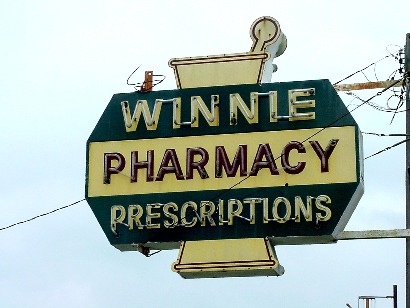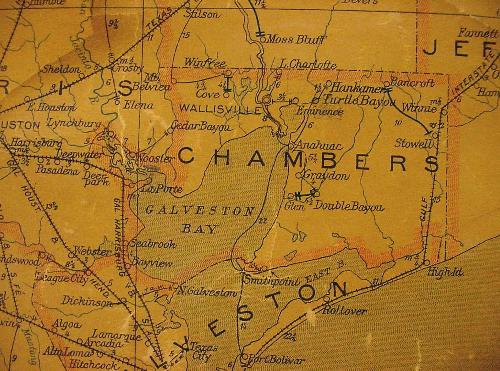Winnie, Texas, Chambers County. (original) (raw)

Winnie Pharmacy old neon sign
TE Photo
History in a Seashell
Although it sounds like a woman's name, Winnie was actually named after Fox Winnie, a railroad contractor. The Gulf and Inter-state Railway was responsible for the town's birth. The town was laid out and a post office opened in 1895.
A company started digging irrigation canals in 1899 and The Winnie and Loan Improvement Company started selling plots. With a shortage of buyers, the company folded by 1911. A hurricane in 1915 discouraged further development and post-World War I rice prices dropped dramatically.
About the only abundant crop beside rice was the lowly fig. Several processing plants were built and it was hoped that figs would be the area's economic salvation. But America isn't exactly crazy over figs - a fact that soon became apparent.
The area remained isolated - due to poor roads and the population was a mere 200 persons through the 1920s.
Winnie and Stowell schools were consolidated in 1931.
The Stowell oilfield was discovered in 1941 and oilman Glenn H. McCarthy developed a gas plant nearby. It was wealth from this area that McCarthy spent on building the Shamrock Hotel in Houston.
With the arrival of Interstate 10, Winnie's population grew - reaching almost 1,200 in the 60's and rising to 2,500 by 1980.
See Historical Markers:
Town of Winnie
Winnie-Stowell
Historical Marker - Chambers County Sub-Courthouse, FM 1406
Town of Winnie
Site is on 1835 James Hoggatt grant from Mexico. As late as 1890s, small tracts were homesteaded here. Named for Fox Winnie (1843-1927), a contractor and investor of Newton, Kans., who with L. P. Featherstone in 1895 built Gulf & Interstate Railway through the area. An 1896 storm destroyed G. & I. R. rail bed. The train, caught in Galveston, waited three years to make return run through Winnie to Beaumont. Winnie Loan & Improvement Company sold acreage and town lots from its offices in Galveston, 1896-1911. Late 1800s economy, based on raising of rice, cattle, fruit, and cotton, suffered from 1895 snow, hurricanes in 1896, 1900, and later, and a severe freeze in 1916.
Pioneer religious worship, held in homes, was led by such settlers as the Rev. T. W. White, a Presbyterian. Churches were built by Baptist, Church of christ, First Assembly of God, Latter Day Saints, Methodist, and Roman Catholic congregations. The one-room early school evolved into a system with several buildings. Site of Chambers County sub-courthouse, Winnie benefits from payrolls of petroleum and chemical industries, and rice, beef, and catfish farming. Great annual celebration is the Texas Rice Festival.
Historical Marker - In County Park, LeBlanc & Park St, Winnie
Winnie-Stowell
Winnie and Stowell are two communities in northeastern Chambers County that were founded in the mid-1890s on the Gulf & Interstate Railway. The towns share a common economic history and cultural heritage and often are referred to simply as Winnie-Stowell.
The town of Winnie was organized by the Winnie Loan and Improvement Co., a corporation based in Galveston that promoted settlement in the townsite. A school and bank were in operation by 1910, and Winnie became the retail center for the surrounding area.
Early settlers in Stowell included the W. W. Gregory and Spencer families and F. W. Schwettman. In 1899 Schwettman helped build the Farmers Canal, which served the area's irrigation needs. The canal proved very successful until a 1915 storm ruined it and most of the surrounding rice fields. During the 20th century irrigation systems improved, which allowed for the successful commercial development of orange, fig, and rice production in the area.
In 1931 the school systems of Winnie and Stowell were combined into one district. This system, along with the establishment of Winnie-Stowell Park in 1957, has provided the two towns with shared interests that have brought them together over the years.
Winnie, Texas Forum
Subject: Winnie Delight
A couple of years ago I was browsing Texas Towns for my church youth choir because we were going to take a WORLD TOUR OF TEXAS TOUR and visit such towns as China, Athens, Paris, Carthage, Italy�.so on and so forth, and I came up on your site, and when I clicked on Winnie (not because of the world tour, but because it�s my home town) I was delighted and surprised to see the neon sign from Winnie Pharmacy on the Winnie page. You see, that was my Dad�s store, and he served as Pharmacist from 1962 till 1988 when he retired. Co pharmacists were John Gaudet and my father, Gerald Barrios. I spend many years at the Pharmacy as a child growing up (the new one was built in 1965) and the neon sign was on the original store across the street and moved there when the new store was open. It brought back great memories, and the sign is such a classic. Thanks for adding it to the Winnie page and for the memories it stirred!!! - Barry Barrios, Katy, Texas, A former Winnie, August 12, 2009
Texas Escapes, in its purpose to preserve historic, endangered and vanishing Texas, asks that anyone wishing to share their local history, stories, landmarks and vintage/historic photos, please contact us.
